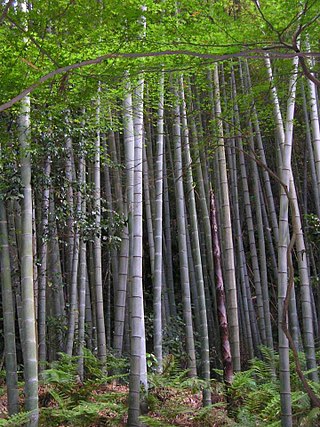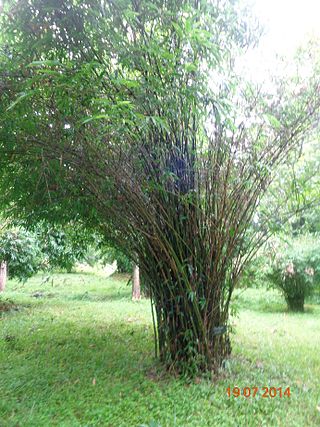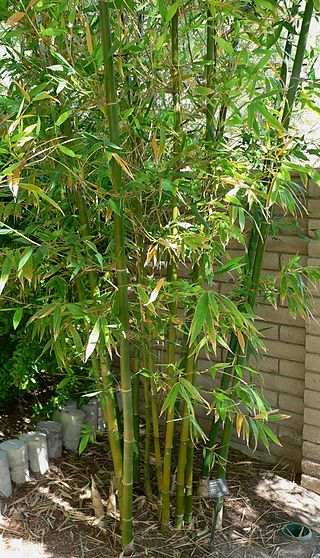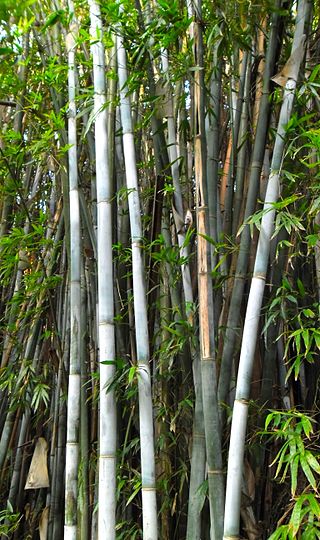
Bamboos are a diverse group of mostly evergreen perennial flowering plants making up the subfamily Bambusoideae of the grass family Poaceae. Giant bamboos are the largest members of the grass family, in the case of Dendrocalamus sinicus individual culms reaching a length of 46 meters, up to 36 centimeters in thickness and a weight of up to 450 kilograms. The internodes of bamboos can also be of great length. Kinabaluchloa wrayi has internodes up to 2.5 meters in length. and Arthrostylidium schombergkii with lower internodes up to 5 meters in length, exceeded in length only by papyrus. By contrast, the culms of the tiny bamboo Raddiella vanessiae of the savannas of French Guiana are only 10–20 millimeters in length by about two millimeters in width. The origin of the word "bamboo" is uncertain, but it probably comes from the Dutch or Portuguese language, which originally borrowed it from Malay or Kannada.

Dendrocalamus is a tropical Asian genus of giant clumping bamboos in the grass family. It is found in the Indian subcontinent, China, and Southeast Asia.

Guadua is a Neotropical genus of thorny, clumping bamboo in the grass family, ranging from moderate to very large species.

Bambusa vulgaris, common bamboo, is an open-clump type bamboo species. It is native to Indochina and to the province of Yunnan in southern China, but it has been widely cultivated in many other places and has become naturalized in several regions. Among bamboo species, it is one of the largest and most easily recognized.
Giant bamboo is a common name for several large species of bamboo and may refer to:
Bambusa longispiculata, or Mahal bamboo, is a species of clumping bamboo native to Bangladesh and Myanmar, but widely grown in many other countries including Australia. Growing in wide and open clumps, it makes an excellent shelter for waterfowl. It is not suited for harvesting and is very suitable for soil stabilization on dam faces. It can grow up to a height of 10 m, and a thickness of 5 cm.

Bambusa tulda, or Indian timber bamboo, is considered to be one of the most useful of bamboo species. It is native to the Indian subcontinent, Indochina, Tibet, and Yunnan, and naturalized in Iraq, Puerto Rico, and parts of South America.

Bambusa oldhamii, known as giant timber bamboo or Oldham's bamboo, is a large species of bamboo. It is the most common and widely grown bamboo in the United States and has been introduced into cultivation around the world. It is densely foliated, growing up to 20 metres tall in good conditions, and can have a diameter of up to 10 centimetres.

Oxytenanthera is a genus of African bamboo. Bamboos are members of the grass family Poaceae.

Bambusa blumeana, also known as spiny bamboo or thorny bamboo, is a species of clumping bamboo occurring in Tropical Asia.

Bamboo shoots or bamboo sprouts are the edible shoots of many bamboo species including Bambusa vulgaris and Phyllostachys edulis. They are used as vegetables in numerous Asian dishes and broths. They are sold in various processed shapes and are available in fresh, dried, and canned versions.

Bambusa bambos, the giant thorny bamboo, Indian thorny bamboo, spiny bamboo, or thorny bamboo, is a species of clumping bamboo native to southern Asia. It is also naturalized in Seychelles, Central America, West Indies, Java, Malaysia, Maluku, and the Philippines.

Fargesia murielae, the umbrella bamboo, is a species of flowering plant in the family Poaceae. It is a large, clump-forming evergreen bamboo, closely resembling Fargesia nitida in the same genus, but with yellow canes.

Bambusa chungii, commonly known as white bamboo or tropical blue bamboo, is a large, tall bamboo species, often found in Hong Kong, and originating in southern China and Vietnam. Its blue-green or white culms often reach a height of 10 m.

Dendrocalamus asper, also known as giant bamboo or dragon bamboo, is a giant, tropical, clumping species of bamboo native to Southeast Asia. In addition to its prolific nature across Asia, the plant's overall attractive appearance has seen this species introduced widely across South America and Africa, as well as Mexico and Florida. One advantage of this bamboo, especially for gardens, is its natural growth habit as a sympodial, colony-forming plant. Overall this bamboo maintains its own "personal" growing space, and does not grow laterally (runners), thus posing less risk of being environmentally-invasive.

Bambusa polymorpha, or Burmese bamboo, is a species of clumping bamboo native to Bangladesh, Laos, Myanmar, Thailand, Sri Lanka, Java, Cuba, Puerto Rico, and Ecuador.
Winner of the U.S. Department of State's 2014 Award for Corporate Excellence, founded in 2010 by Troy Wiseman and Camille Rebelo, EcoPlanet Bamboo has pioneered the industrialization of bamboo as an alternative fiber for timber manufacturing industries. To date the Company has 37,250 acres of bamboo farms under ownership, in Central American, Western and Southern Africa, with larger scale plantations underway.

Bambusa textilis, also known as slender bamboo, clumping bamboo and weaver's bamboo, is a species of bamboo in the Poaceae (grasses) family that is native to China. The subspecies var. gracilis is heavily cultivated in Australia.

Mullerochloa is a monotypic genus of flowering plants belonging to the family Poaceae. It just contains one species, Mullerochloa moreheadiana(F.M.Bailey) K.M.Wong
















